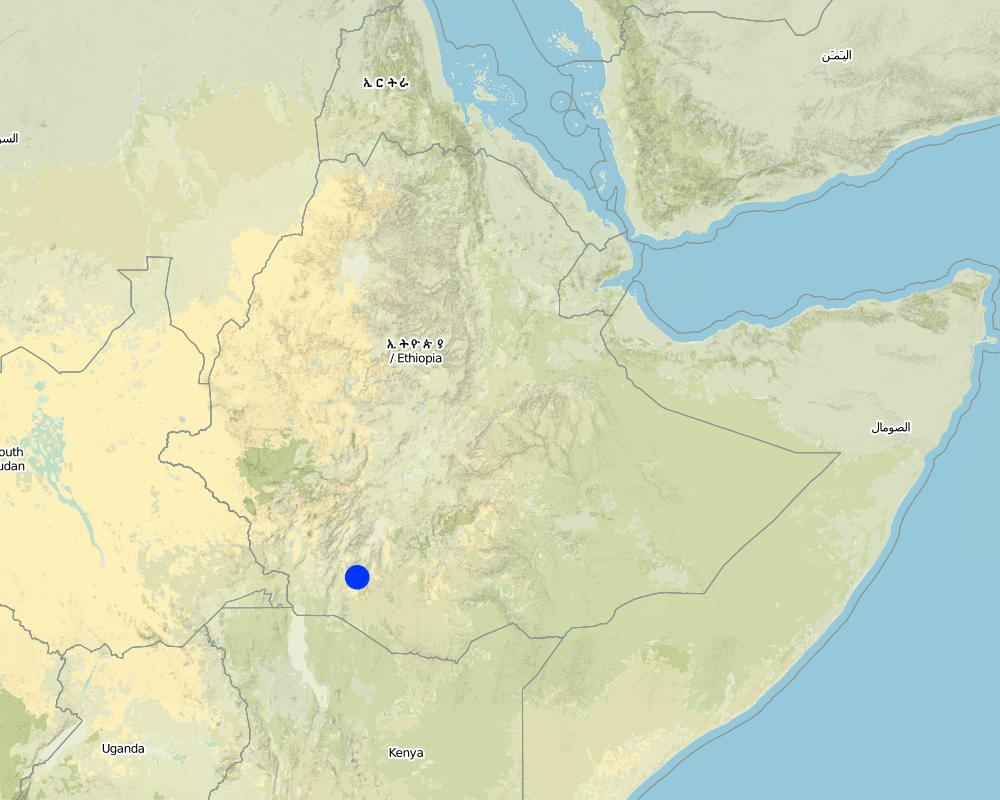Labour exchange [埃塞俄比亚]
- 创建:
- 更新:
- 编制者: Unknown User
- 编辑者: –
- 审查者: Fabian Ottiger
approaches_2674 - 埃塞俄比亚
查看章节
全部展开 全部收起1. 一般信息
1.2 参与方法评估和文件编制的资源人员和机构的联系方式
1.3 关于使用通过WOCAT记录的数据的条件
编制者和关键资源人员接受有关使用通过WOCAT记录数据的条件。:
是
1.4 SLM技术问卷的参考

Terrasses en banquettes Konso [埃塞俄比亚]
Un talus en pierres selon les courbes du niveau en nivelant progressivement la terre entre deux niveaux afin de contrôler l'érosion du sol.
- 编制者: Daniel Danano
2. SLM方法的描述
2.1 该方法的简要说明
It is an approach based on labour exchange organized on the basis of mutual assistance involving no payment for work done. However, the land user is supposed to provide people participating with food and drinks. All wanting such cooperation request the me
2.2 该方法的详细说明
该方法的详细说明:
Aims / objectives: To alleviate the labour shotage each member of the labour exchange group could request for assistance any time farm activities need to be performed. The objective of the approach is to strengthen the relationship among the community members. It is further intended to make the community members share experience, skills and technical know-how on soil and water conservation activities.
Role of stakeholders: A farmer request individuals from the community members to get support.The request is made ahead of time in informing individual farmers about the programme (one to two weeks ahead) so that participants get enough time to prepare. The farmer who seeks assistance should prepare food and local drinks. And in the mean time, the farmer has to remind those who are requested for help so that all invited farmers participate. The participants avail themselves on the specified date with all necessary farm implements required for the activity. In this approach particularly for soil and water conservation activities participants shold be men. For weeding and harvesting women involve more than men because they can carry more weights than men.
2.5 采用该方法的国家/地区/地点
国家:
埃塞俄比亚
区域/州/省:
Konso, SNNPR
Map
×2.7 方法的类型
- 传统/本土
2.8 该方法的主要目的/目标
The Approach focused mainly on other activities than SLM (Approach is used mostly on activites like land preparation, sowing and weeding. Community members help each other in contributing labour contributing labour on the basis of mutual understanding)
To solve the labour constraints faced by that some members of the community.
The SLM Approach addressed the following problems: Shortage of labour
2.9 推动或妨碍实施本办法所适用的技术的条件
财务资源和服务的可用性/可得性
- 阻碍
Lack of finance to hire labour
Treatment through the SLM Approach:
法律框架(土地使用权、土地和水使用权)
- 启动
The practice has been there before the existing land ownership policy came into existance and it still exists after it.
其他
- 阻碍
Shortage of grain. A farmer to benefit from labour exchange he has to have enough food crop in which he can make food and drink.
Treatment through the SLM Approach:
3. 相关利益相关者的参与和角色
3.1 该方法涉及的利益相关者及其职责
- 当地土地使用者/当地社区
Men mainly undertake SWC activities but women equally take part in other farm activities.
According to the farmers view men are wise (have more wisdom on indegenous technical knowledge than women). The SWC work is tedious and requires more energy to perform. No significant difference among different classes or status in the community in dicision making because the approach is mainly designed to help those who require labour assisstance for their farm activities.
3.2 当地土地使用者/当地社区参与该方法的不同阶段
| 当地土地使用者/当地社区的参与 | 指定参与人员并描述活动 | |
|---|---|---|
| 启动/动机 | 无 | |
| 计划 | 无 | |
| 实施 | 无 | |
| 监测/评估 | 无 | |
| Research | 无 |
3.4 有关SLM技术选择的决策
具体说明谁有权决定选择要实施的技术:
- 仅限土地使用者(自主)
解释:
land user driven (bottom-up)
Decisions on the method of implementing the SLM Technology were made by by land users* alone (self-initiative / bottom-up). land user driven (bottom-up)
4. 技术支持、能力建设和知识管理
4.3 机构强化(组织发展)
是否通过这种方法建立或加强了机构?:
- 否
5. 融资和外部物质支持
5.2 为土地使用者提供财政/物质支援
土地使用者是否获得实施该技术的财政/物质支持?:
是
5.3 对特定投入的补贴(包括劳动力)
- 无
如果土地使用者的劳动力是一项重要的投入,那么是不是:
- 自愿
注释:
Local food and drink after work
5.4 信用
是否根据SLM活动的方法给予信用值?:
否
6. 影响分析和结论性陈述
6.1 方法的影响
该方法是否帮助土地使用者实施和维护SLM技术?:
- 否
- 是,很少
- 是,中等
- 是,支持力度很大
Since the practice has evolved locally the farmers have no problem in practicing it.
该方法是否改善了阻碍SLM技术实施的土地使用权/用户权问题?:
- 否
- 是,很少
- 是,中等
- 是,支持力度很大
The approach has no relation with land ownership or land use rights.
Did other land users / projects adopt the Approach?
- 否
- 是,很少
- 是,中等
- 是,支持力度很大
6.3 方法活动的可持续性
土地使用者能否维持通过该方法实施的措施(无外部支持的情况下)?:
- 是
6.4 该方法的长处/优点
| 土地使用者眼中的长处/优势/机会 |
|---|
| The one who had few children to help him in farm activities benefited more from the system |
| Created a better understanding on labour exchange among the community |
| 编制者或其他关键资源人员认为的长处/优势/机会 |
|---|
| Labour problem alleviated (How to sustain/ enhance this strength: The system by it self is sustainable because it has evolved and developed with in the community.) |
| All farming activities can be accomplished according to their seasonal calender |
| Every member of the community has got awarness on each farm activities |
| Social relationship among the communit becames stronger |
| The farmers can cope up adverse environmental conditions |
6.5 该方法的弱点/缺点以及克服它们的方法
| 土地使用者认为的弱点/缺点/风险 | 如何克服它们? |
|---|---|
| To some extent the system favours the rich people than the resource poor households | |
| The farmer with many children has got more chance of getting all the participants expected during labour day |
| 编制者或其他关键资源人员认为的弱点/缺点/风险 | 如何克服它们? |
|---|---|
| No one is volantary to participate if in case the farmer is unable to provide food and drink | The system should be modified in such away that the participantes should have their own food and drink so that the problem of resource poor farmer is alleviated. |
7. 参考和链接
7.1 方法/信息来源
- 实地考察、实地调查
- 与土地使用者的访谈
链接和模块
全部展开 全部收起链接

Terrasses en banquettes Konso [埃塞俄比亚]
Un talus en pierres selon les courbes du niveau en nivelant progressivement la terre entre deux niveaux afin de contrôler l'érosion du sol.
- 编制者: Daniel Danano
模块
无模块


